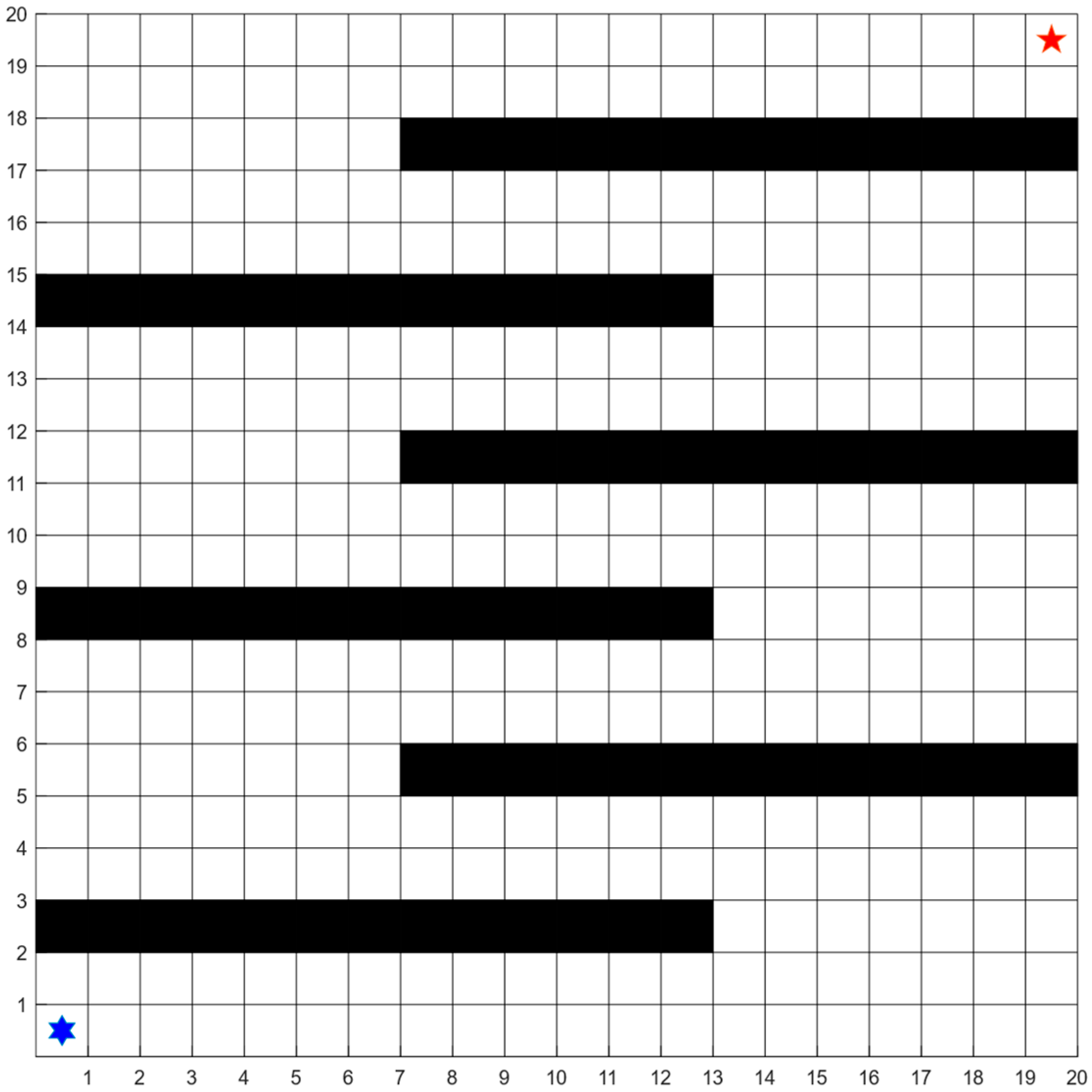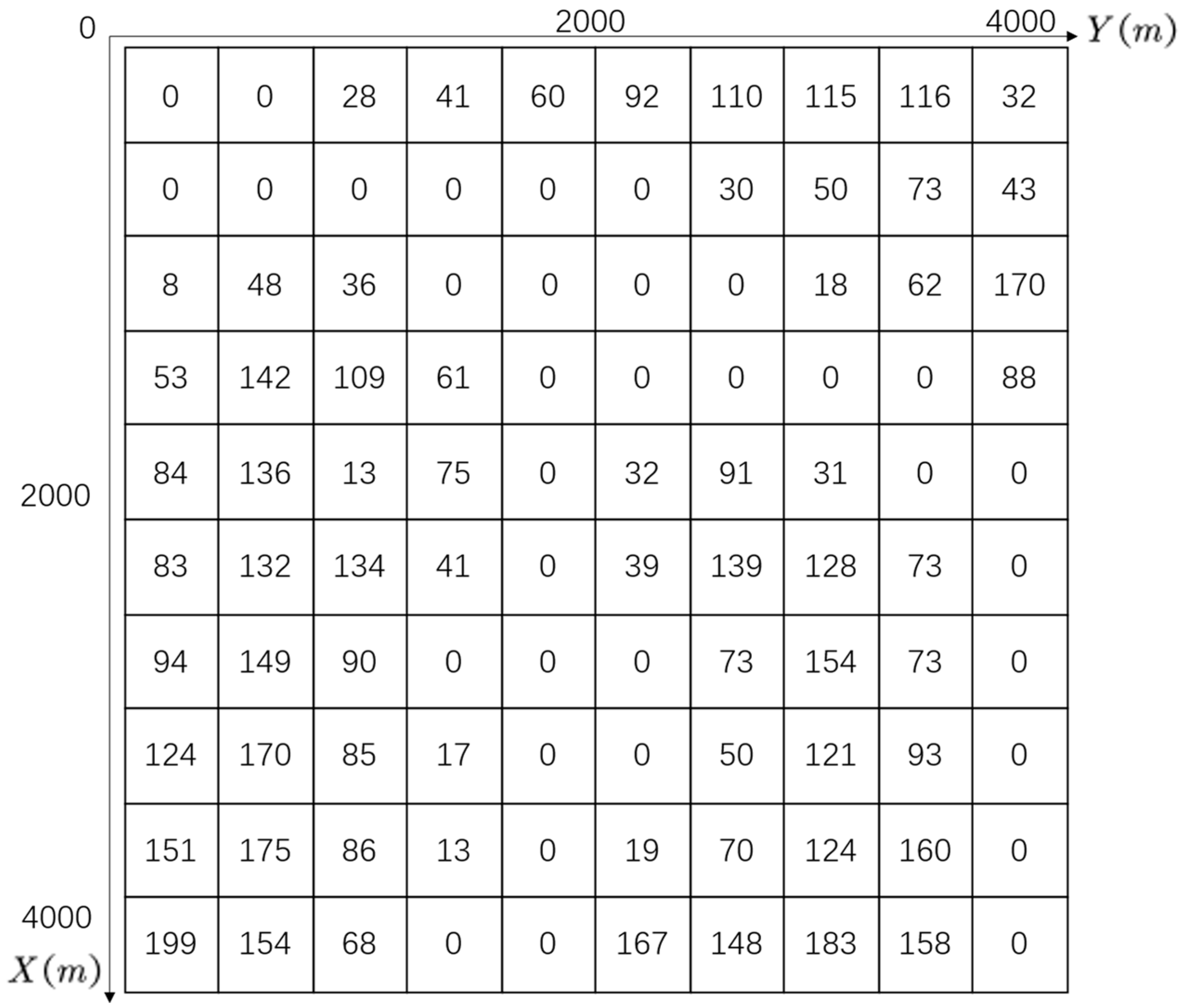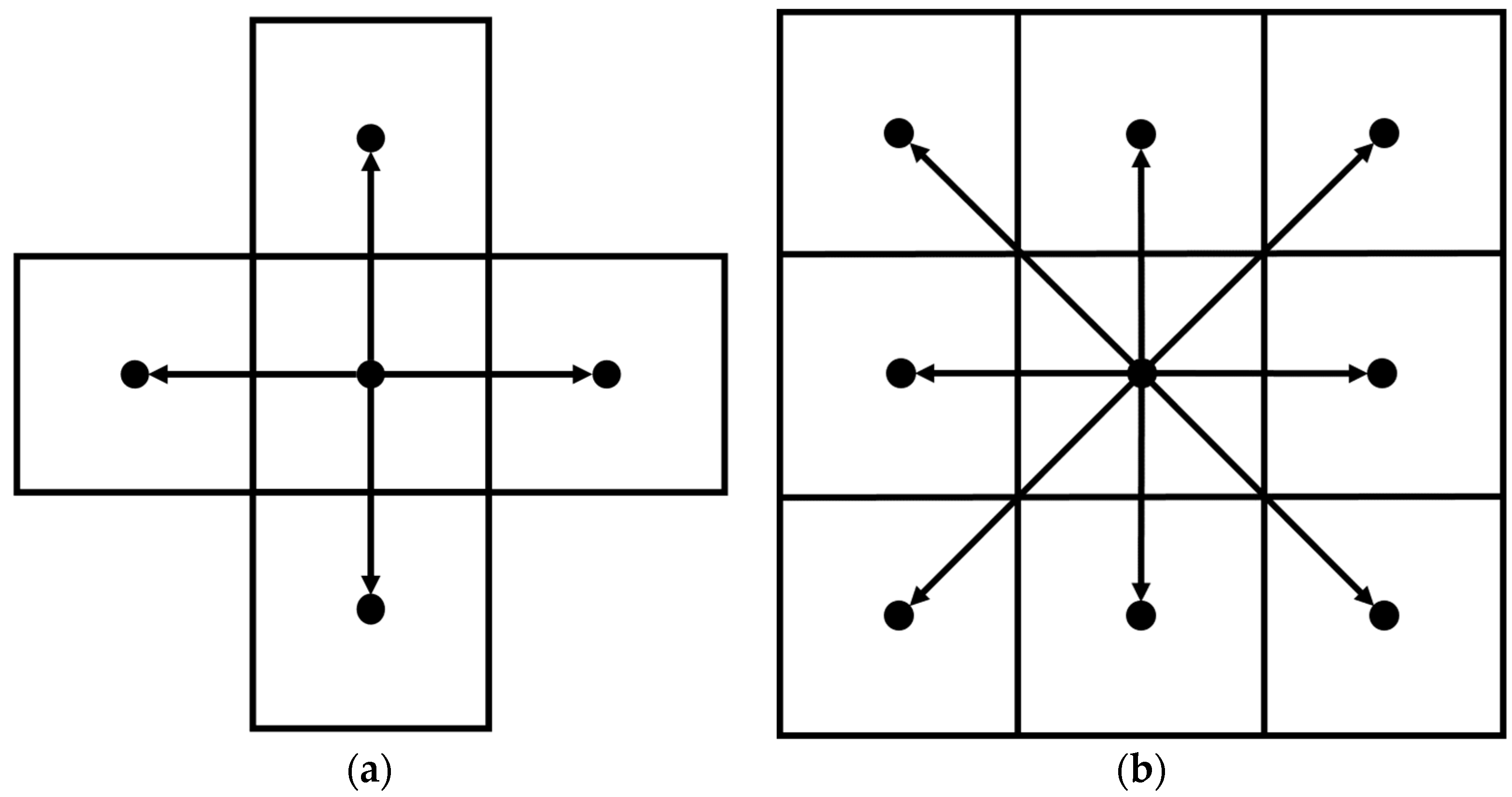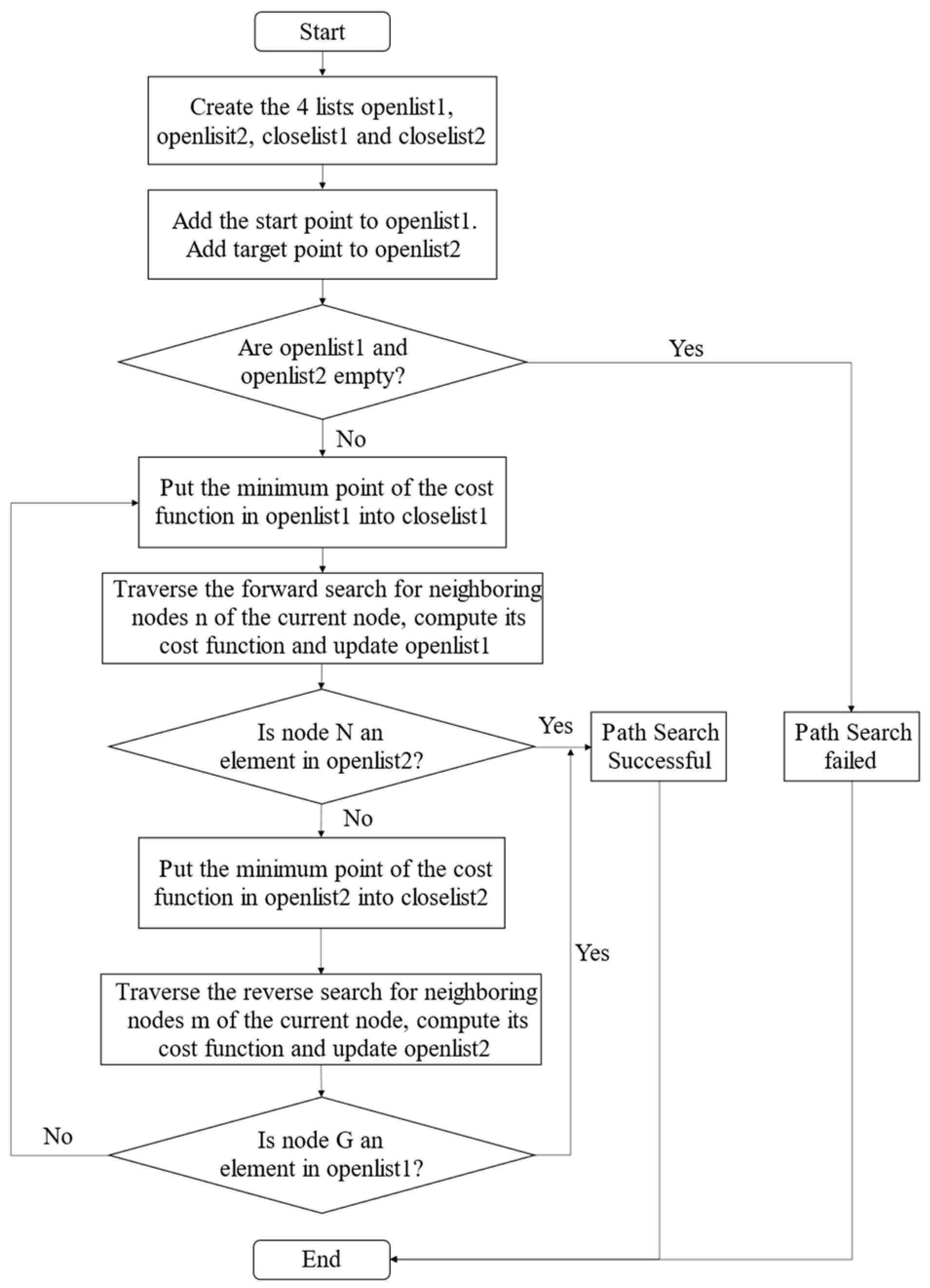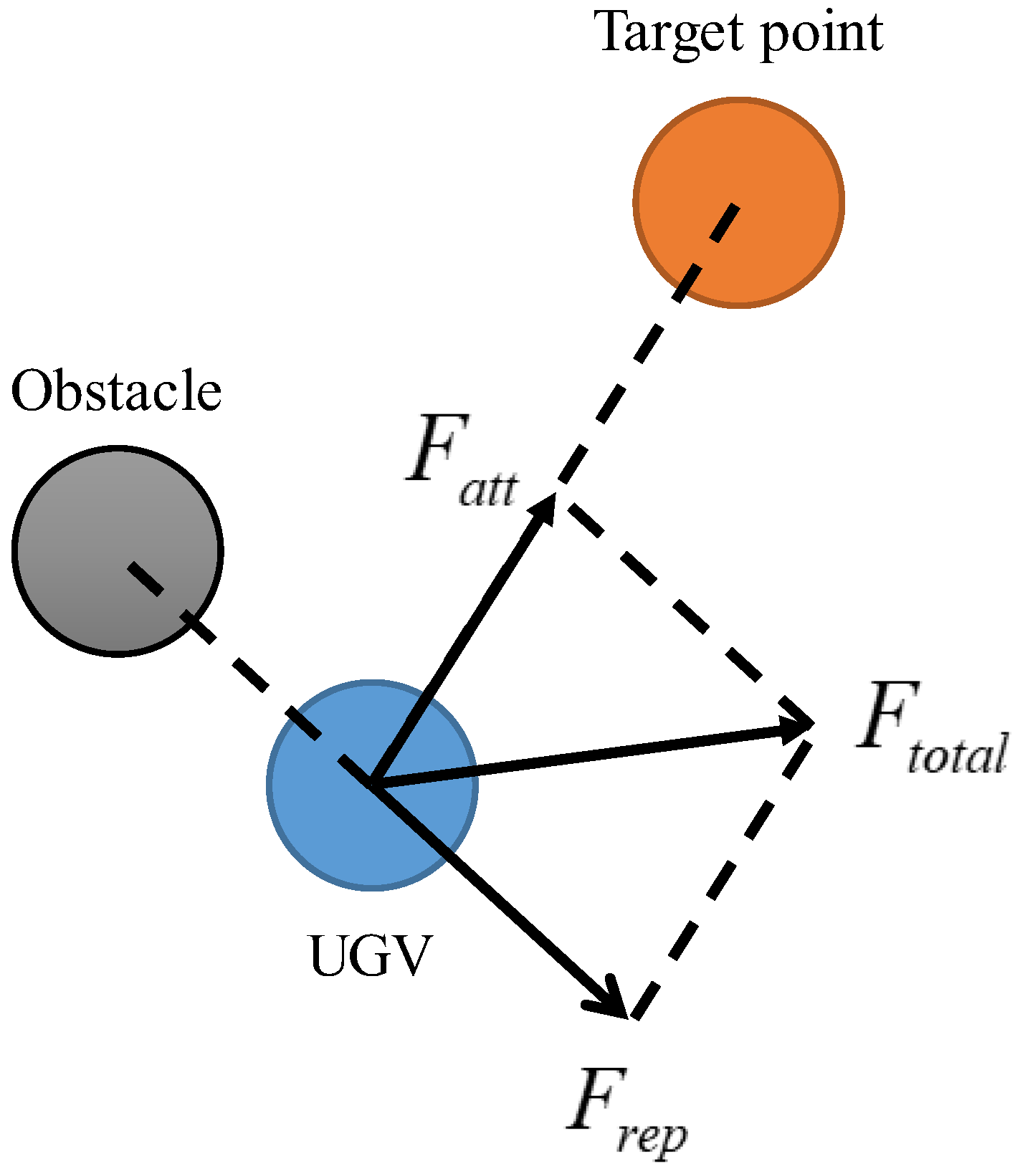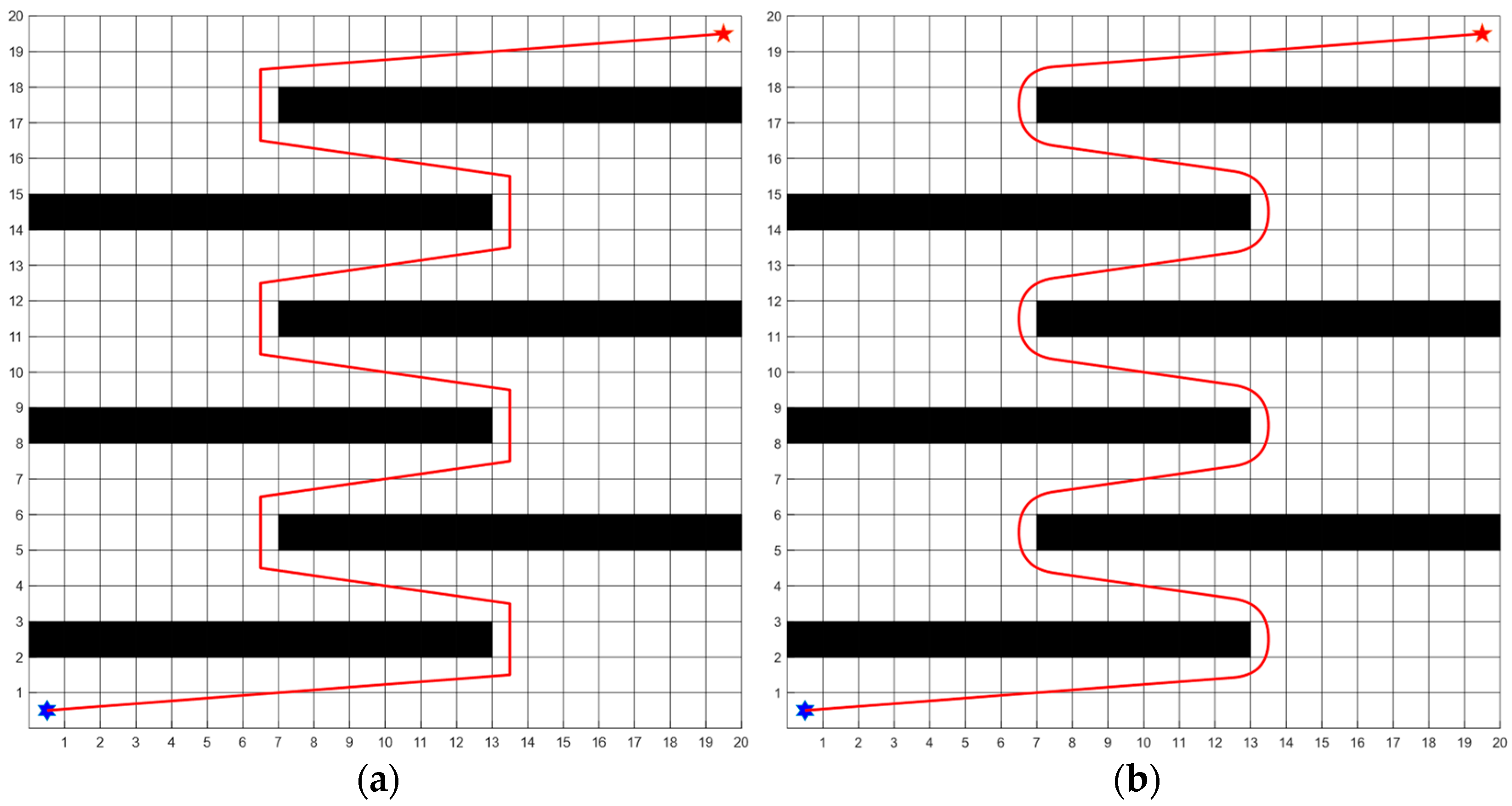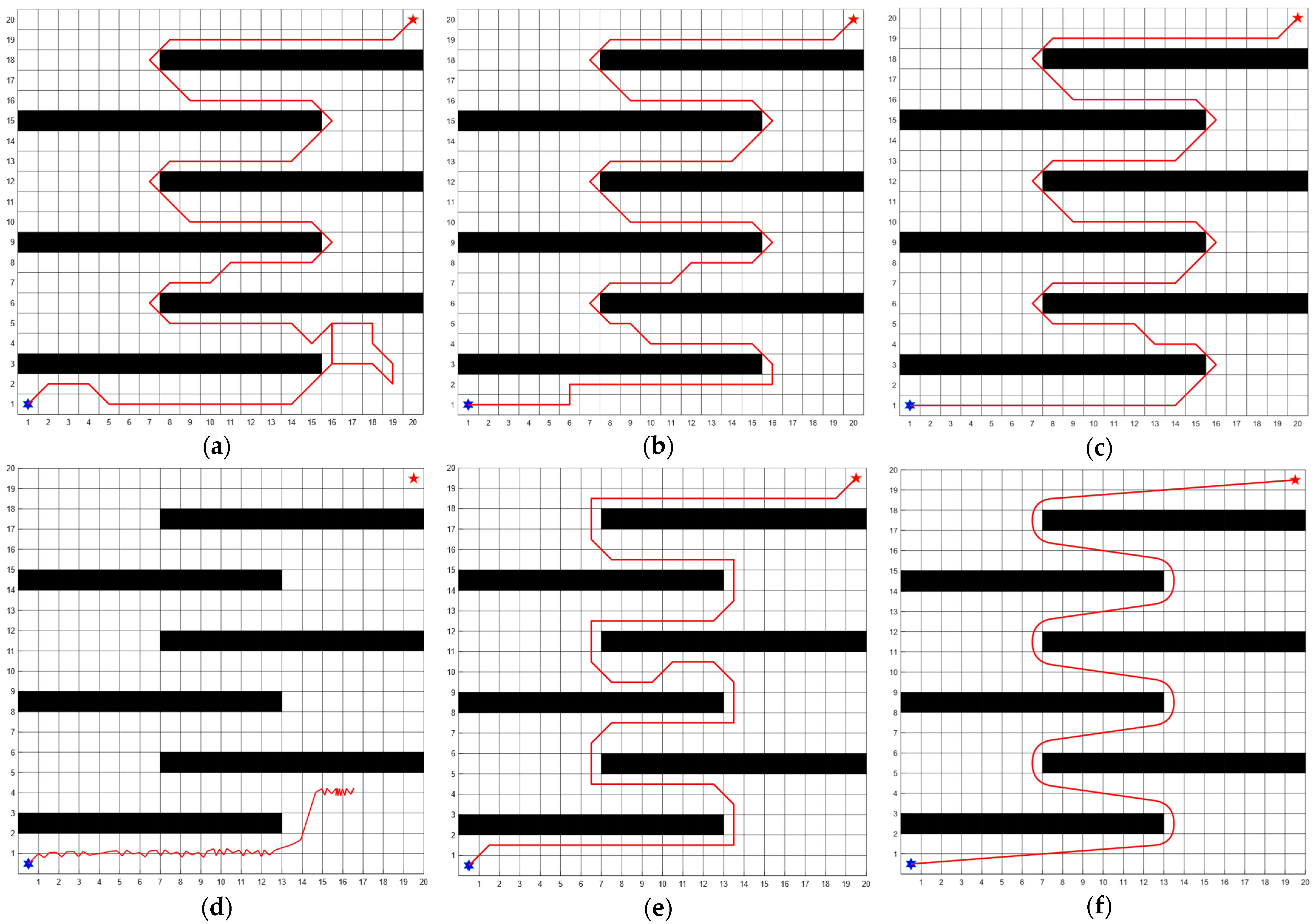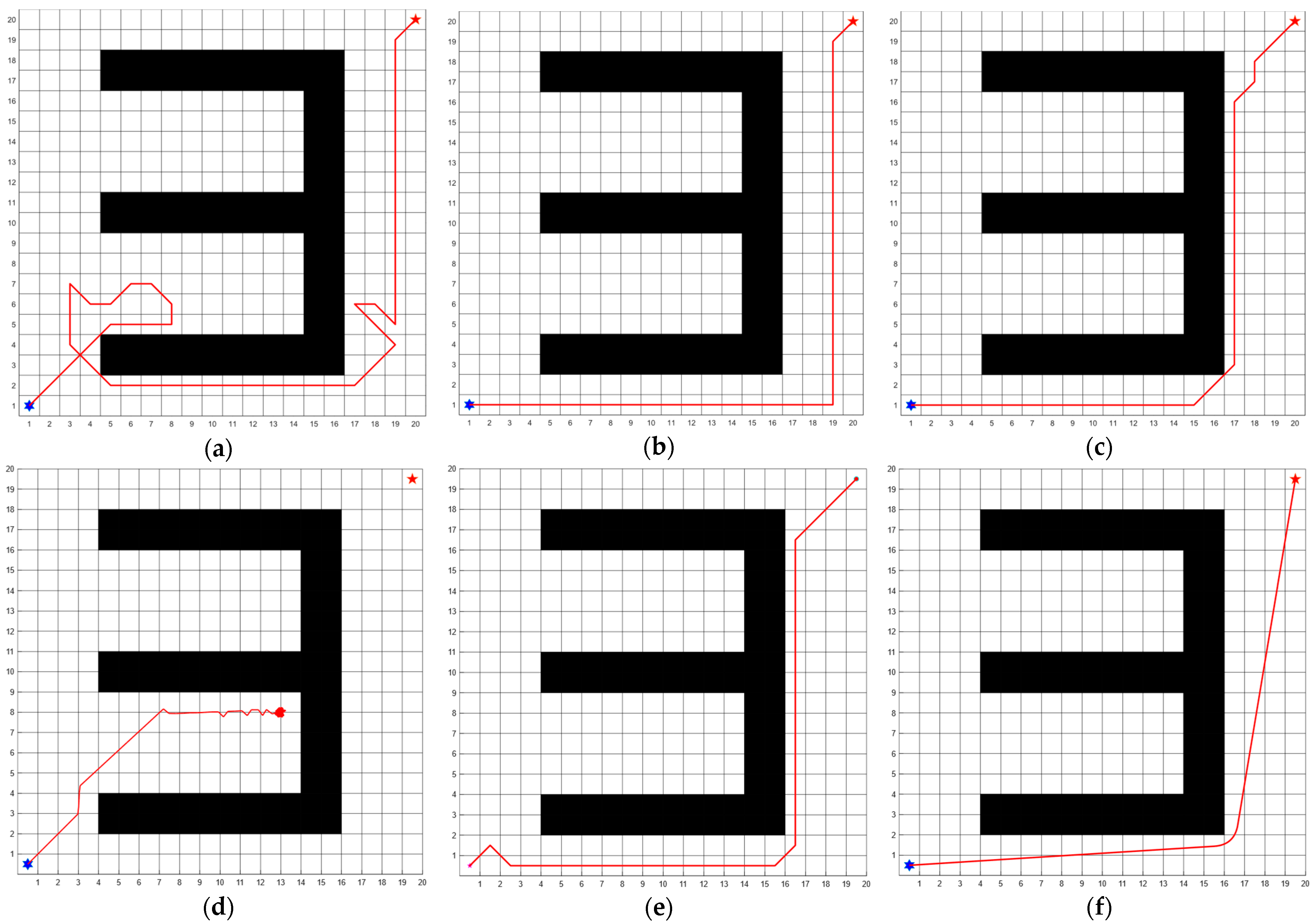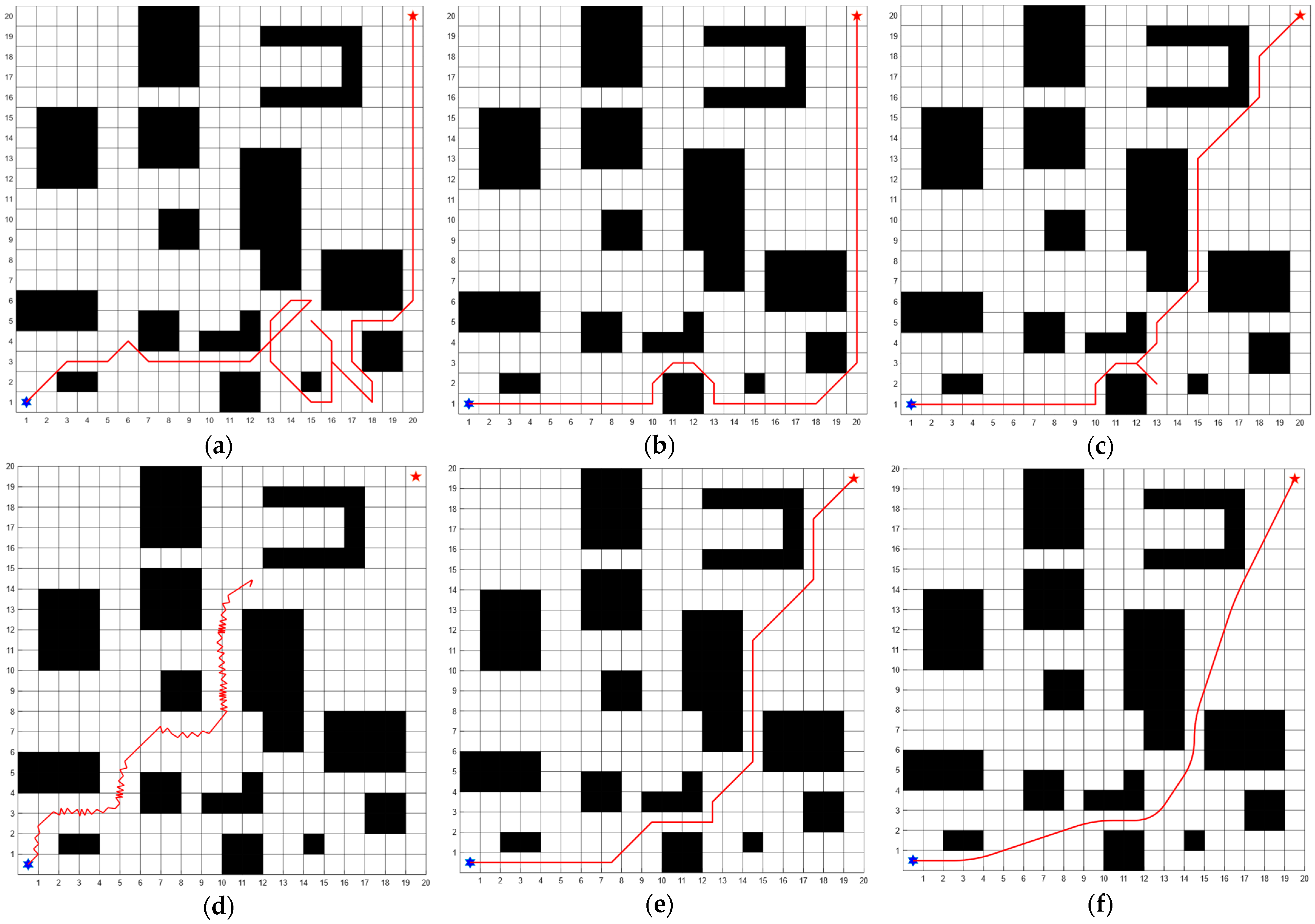Currently, in most cases, various heuristic algorithms are still used to solve the path planning problem. Path planning methods for UGV are usually categorized into two main groups: traditional search algorithms and intelligent bionic algorithms.
Zhang et al. [
13] introduced a pioneering real-time navigation strategy for unmanned surface vehicles (USVs) to navigate complex environments with multiple obstacles. Leveraging Artificial Potential Field (APF) technology and Differential Vector Field (DVF) guidance principles, their approach focuses on safe, efficient path planning and multi-obstacle avoidance. This innovative combination enhances USV’s ability to track targets effectively while navigating through unpredictably dynamic spaces, representing a significant advancement in autonomous maritime navigation. Josu Agirrebeitia et al. [
14] crafted a novel UAV path planning algorithm utilizing the Artificial Potential Field (APF) method, tailored for obstacle-laden environments. This algorithm stands out for its adept obstacle avoidance in intricate settings, showcasing remarkable efficiency in both two-dimensional and three-dimensional spaces. Their contribution signifies a significant leap in UAV navigation technology, offering enhanced maneuverability across diverse spatial challenges. Wolfgang Fink et al. [
15] developed a multi-objective extended Dijkstra algorithm based on terrain data to cope with the problem of rover path planning that requires extensive time-consuming manual surface terrain analysis. The algorithm was optimized for multiple constraint conditions, creating favorable conditions for scientific research and investigation. Yong Ma et al. [
16] proposed an IBA* algorithm for the coverage path planning of unmanned ground surveying vehicles, which overcomes the problem of insufficient continuity in the BA* algorithm through task decomposition and dynamic mapping updates. Experiments have shown that this algorithm can effectively ensure the safety of UGV during map mapping. Shanen Yu et al. [
17] introduced the SOF-RRT* algorithm, designed to boost UAV navigation efficiency in complex areas. Key benefits include shorter, smoother paths, fewer random tree nodes, and fewer iterations needed for planning. This algorithm significantly cuts down iteration numbers, reduces path lengths, and quickens convergence, marking a notable improvement over traditional path planning methods. SOF-RRT* stands out by offering enhanced navigation efficiency and performance enhancements in UAV path planning. Qingyang Gao et al. [
18] developed the BP-RRT algorithm, blending back propagation neural networks with an optimized rapidly expanding random tree (RRT) algorithm for robotic path planning. This approach addresses the inefficiency and high computational demands of navigating a six-degree-of-freedom robotic arm through complex 3D environments filled with obstacles. The BP-RRT algorithm strategically partitions the sampling space and adjusts sampling probabilities for more effective local sampling, particularly in dynamic or obstacle-rich areas. Experimental simulations have shown its superior performance and adaptability across various conditions, outpacing traditional path planning methods and demonstrating marked improvements in speed against comparable RRT* algorithms. Jiaming Fan et al. [
19] innovated a UAV trajectory planning method using a dual-track APF-RRT (Artificial Potential Field-Rapid Exploration Randomized Tree) algorithm to address the limitations of traditional RRT algorithms, such as redundancy, multiple iterations, and excessively long paths. Their approach significantly improves the tree-growth search performance and computational efficiency in path planning, while substantially improving the quality of the planned paths. They used an improved bi-directional APF-RRT strategy to increase efficiency and path planning quality, thus optimizing UAV navigation strategies in complex environments. Yanming Liang et al. [
20] introduced the CCPF-RRT* algorithm, an innovative extension of the Rapid Exploration Random Tree Star (RRT*) focused on heuristic optimal path planning. This method is designed to boost robotic navigation efficiency in dense and complex settings by employing a potential function-based strategy for path optimization. Key advancements include the algorithm’s ability to guide robots through crowded spaces with optimal paths, enhancing overall efficiency and minimizing the cost of navigation. The CCPF-RRT* has shown remarkable capabilities in swiftly generating initial solutions, achieving rapid convergence, and crafting low-cost motion paths in intricate environments.
Chengzhi Qu et al. [
21] developed a novel hybrid algorithm, HSGWO-MSOS, which integrates elements of the gray wolf optimization (GWO) and the symbiotic organisms search (SOS) algorithms. This innovative approach simplifies GWO to maintain its exploratory strength while significantly boosting convergence speed beyond the traditional GWO benchmarks. Additionally, the SOS algorithm’s symbiosis phase has been tailored for enhanced efficiency. The performance of the HSGWO-MSOS algorithm is meticulously evaluated using the linear difference equation method, revealing its exceptional ability to identify optimal paths efficiently. This hybrid algorithm stands out for its rapid execution and superior performance, making it a groundbreaking solution for UAV path planning in challenging environments. Imanshu Gupta et al. [
22] proposed a novel hybrid optimization algorithm, known as HCPSOA, where they combined Particle Swarm Optimization (PSO) and Gray Wolf Optimization (COA). The goal of the algorithm is to overcome the difficulty of estimating the flight trajectory of an unmanned aerial vehicle (UAV) under various constraints with acceptable accuracy and time span in a complex 3D environment. It improved convergence speed, reduced the possibility of local minimum value reductions, and overcame the limitations of COA and PSO. The results of the simulation experiments show that HCPSOA estimates better and safer flight paths with fewer iterations, and the ability to search for flight paths has been greatly improved. Yan Ma et al. [
23] crafted an advanced hybrid algorithm inspired by the flame ant colony concept, designed specifically for unmanned underwater vehicle (UUV) path planning. This innovative approach aims to address the difficulties UUVs encounter when moving through environments affected by ocean currents and physical obstacles. Through simulation experiments, the algorithm has proven its ability to efficiently determine optimal paths within complex marine settings, significantly improving UUV navigation under challenging underwater conditions. Zheng Wang et al. [
24] have developed a novel hybrid algorithm that synergizes global and local path planning techniques, tailored for complex marine navigation. This approach leverages an Enhanced Particle Swarm Optimization (PSO) algorithm to carve out an optimized global route, complemented by an advanced Artificial Potential Field (APF) algorithm for dynamic obstacle avoidance, fine-tuning the path based on global insights. This dual-strategy algorithm adeptly meets the dual challenges of optimizing paths and navigating around dynamic obstacles, significantly improving the operational efficiency of unmanned boats in intricate offshore environments. By integrating these improved algorithms, Zheng Wang et al. offer a sophisticated solution that boosts the navigational capabilities of unmanned marine vessels, facilitating their successful mission execution in demanding marine settings. Zhiheng Yu et al. [
25] have developed a unique algorithm that combines the water flow potential field method with the beetle antenna search strategy, aiming to overcome the limitations inherent in the standalone beetle antenna search method, such as local optimization pitfalls, general inefficiency, and inadequate obstacle navigation during path planning. Through rigorous simulation experiments, this integrated approach has proven to significantly enhance path planning capabilities, yielding benefits like shortened planning durations, superior path optimization, and effective circumvention of local optima. This novel algorithm marks a notable advancement in the domain of mobile robot path planning, successfully addressing prevalent challenges by harnessing the synergistic potential of merging two distinct navigational strategies to derive markedly improved outcomes. Lianghan Zeng et al. [
26] crafted a path planning methodology designed to anticipate ground threats, employing the Artificial Bee Colony (ABC) algorithm enhanced by a collaborative thinking strategy. This approach focuses on mitigating the adverse effects of incomplete ground threat data on the path planning of Unmanned Aerial Vehicles (UAVs). Through simulation experiments, their method has been validated to secure safe flight paths for UAVs, proving its efficacy in environments where ground threat information is not only incomplete but also subject to dynamic changes. Tiancheng Wang et al. [
27] critiqued the conventional Ant Colony Optimization (ACO) algorithms for correlating pheromone concentration with path length, leading to redundancies, and innovatively introduced a Monte Carlo-based Improved Ant Colony Optimization Algorithm (MC-IACO) tailored for welding robot path planning. Through simulation experiments, MC-IACO was shown to significantly outperform both traditional and other enhanced algorithms in optimizing path planning for welding robots, showcasing superior efficiency and precision. This advancement addresses common pitfalls in existing ship path planning algorithms, such as slow convergence, unnecessary detours, and rough path formation, which compromise navigational effectiveness and safety. To address these issues, Qiyong Gu et al. [
28] developed the PI-DP-RRT method, a novel approach aimed at enhancing ship path planning. This method promises significant improvements by streamlining the path planning process, notably increasing both efficiency and accuracy, reducing the frequency of turns, and thereby elevating the overall safety and efficiency of ship navigation. Through simulation experiments, the PI-DP-RRT method has demonstrated its ability to effectively resolve the shortcomings of existing algorithms. Xiaohong Li et al. [
29] crafted an advanced compression factor particle swarm optimization algorithm tailored for Autonomous Underwater Vehicles (AUVs), designed to navigate through difficult currents and obstacles, producing safe and smooth three-dimensional paths. Their experimental findings underscore substantial enhancements in both the efficiency and quality of path planning, marking a pivotal advancement in AUV navigation by significantly optimizing for safety, smoothness, and expedited planning capabilities. Chao Liu et al. [
30] observed that the traditional ACO algorithm suffers from problems such as inefficient search and easy stagnation. Therefore, they proposed a new variant of ACO called Improved Heuristic Mechanism ACO (IHMACO). Simulation experiments show that IHMACO is highly practical and efficient in practical applications, and can obtain the optimal solution of the corresponding path planning problem. This method provides an effective improvement program for path planning.
Researchers have made notable advancements in traditional search and intelligent bionic algorithms for UGV path planning, significantly boosting their efficiency across diverse, complex scenarios. However, despite these improvements, certain algorithms still exhibit drawbacks, such as failing to secure optimal or near-optimal paths in dynamic environments, generating paths that lack smoothness, and featuring excessive rotation angles. These shortcomings underscore the challenges in adapting these algorithms for practical, real-world applications where the demand for efficiency and navigational precision is paramount.
